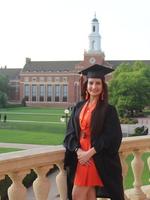
Research papers are a pairing of two 18 minute presentations followed by 18 minutes of Discussion led by a Discussant, with remaining time for Q & A.
This is presentation 1 of 2, scroll down to see more details.
Other presentations in this group:





The Pop-up movement has roots in the participatory culture of new media literacy in which access to readily available and easy to use tools provide a digital environment in which people are not simply consumers of information, but also have the capability to collaborate and network to produce media (Jenkins, et al., 2009). Hallmarks of participatory culture are low barriers for access, support for creating and sharing, informal mentoring, belief that participant contributions matter, and degree of social connectedness leading to collaborative problem-solving and community involvement. This kind of participatory culture is also fostered in makerspaces (Toombs, Bardzell, & Bardzell, 2014). Seymour Papert, often referred to as the “Father of the Maker Movement” (Martinez & Stager, 2013, p. 17), emphasized the importance of face-to-face interactions with a mix of skill levels from novices to experts for optimal learning in informal, social settings (Papert, 1972).
Recruitment and Sampling. Project participants were recruited in stages. Initially, the Advisory Board was formed with community stakeholders recru to both select a community challenge and serve as part of the project evaluation team. The project Design Team was recruited to develop mini challenges for the STEAM Studio sessions. Once the challenge and studio sessions were developed, family and other intergenerational participants were recruited via Library and school networks, and advertising in local community email and social media campaigns.
Data Collection and Analyses. The research included the collection of both qualitative and quantitative data. A mixed methods design included the following methods of data collection and analyses. 1. Participants in the Popup STEAM Studio took surveys before beginning the making session and after. 2. The research team and facilitators observed individuals and groups using cameras to capture photos and videos. Short interviews of participants followed the making sessions. 3. Digital storytelling panels were created from the photos and videos. 4. The digital stories were analyzed for evidence of the Learning Practices of Making.
We have findings and results from the first two years of implementing the popups and the third round will be completed prior to ISTE 23. Findings from the first two popups series include:
1. The Design Team engaged in the Learning Practices of Making when designing and testing ideas for the Popup STEAM Studios Community Challenge.
2. Some Learning Practices of Making can be captured and recorded through digital storytelling. Some LPM are challenging to capture through digital storytelling and need the support of observation and interview transcripts.
3. More familiar social media outlets support a participatory culture for sharing stories of making.
The project built a collaborative infrastructure and capacity for small and rural communities by bringing together resource providers and experts to identify and design science-oriented challenges. Recommendations for other communities wishing to develop similar community challenges will be shared.
Although descriptions of pop-up makerspaces exist on blogs and websites, there is little research on models for collaboration and civic engagement, who participates, and identities associated with stakeholders or participants. Even in pop-up museum guidelines, there is no description of or mention of how topics or themes are determined (Gant, 2013). The small amount of research and descriptions that exist include examples of case studies that focused on the role of technological toolkits and materials, but without a focus on civic engagement (Pandey & Srivastava, 2016), and a collaborative teacher action research project designed to improve high school student engagement through making (West-Puckett, 2016). In response to some of the critiques of formal makerspaces and given the lack of information on pop-ups, the research team proposed a series of pop-up makerspace sessions designed in collaboration with community voices to determine a common, community challenge that integrates both art and science. The project builds a collaborative infrastructure and capacity for small and rural communities by bringing together resource providers and experts to identify and design science-oriented and art-forward challenges to engage the public with science in their community. ISTE attendees who aspire to provide STEAM opportunities to a community will benefit from the successes and failures of our experience.
ALA. (2003). One Book One Community: Planning your community-wide read. Public Programs Office of the American Library Association.
Brahms, L. & Crowley, K. (2016). Making Sense of Making: Defining Learning Practices in MAKE Magazine.Makeology: Makers as Learners, 2. http://upclose.pitt.edu/articles/2015%20brahms_crowley_making_practices.pdf
Brahms, L. & Wardrip, P. S. (2015). Learning Practices of Making: Developing a Framework for Design. In Proceedings of the 14th International Conference on Interaction Design and Children (IDC 2015). Association for Computing Machinery, New York, NY, USA, 375-378. https://doi.org/10.1145/2771839.2771920
Brahms, L. & Wardrip, P. S. (n.d.). Models of Learning. Making + Learning in Museum and Library Makerspaces by Institute of Museum and Library Services and Children’s Museum of Pittsburgh, 45-49.
https://www.imls.gov/sites/default/files/publications/documents/makinglearning-museumslibraries-practitionersguideframework.pdf
Braun, V., & Clarke, V. (2006). Using Thematic Analysis in Psychology. Qualitative Research in Psychology, 3, 77–101.
Cleland, J., & MacLeod, A. (2021). The visual vernacular: embracing photographs in research. Perspectives on Medical Education, 10, 230–237. https://doi.org/10.1007/s40037-021-00672-x
Close, H. (2007). The use of photography as a qualitative research tool. Nurse researcher, 15, 27-36. https://doi.org/10.7748/nr2007.10.15.1.27.c6052
Forman, G. and Fyfe, B. (2012). Negotiated learning through documentation, discourse and design. In C. Edwards, L. Gandini & G. Forman (Eds.), The hundred languages of children: The Reggio Emilia approach to early childhood education (3rd edition). New Jersey: Ablex Publishing Corporation.
Galloway, A. (2015). Bringing A Reggio Emilia Inspired Approach into Higher Grades - Links to 21st t Century Learning Skills and the Maker Movement. [Master of Education dissertation, University of Victoria].
Gant, N. (n.d.). How to make a pop-up museum: An organizer's kit. Santa Cruz, CA: Santa Cruz Museum of Art & History.
Glaw, X., Inder, K., Kable, A., Hazelton, M. (2017) Visual Methodologies in Qualitative Research: Autophotography and Photo Elicitation Applied to Mental Health Research. International Journal of Qualitative Methods. https://doi.org/10.1177/1609406917748215
Glesne, C. (2016). Becoming qualitative researchers: An introduction (5th ed.). Pearson.
Halverson, E. R., & Sheridan, K. M. (2014). The maker movement in education. Harvard Educational Review, 84(4), 4995-504.
Hanna, H. (2020). Photography as a Research Method with Learners in Compulsory Education: A Research Review, Beijing International Review of Education, 2(1), 11-34. https://doi.org/10.1163/25902539-00201003
Harel, & Papert, S. (1991). Constructionism: Research reports and essays 1985-1990. Praeger/ABC-CLIO.
Jenkins, H., Purushotma, R., Weigel, M., Clinton, K., & Robison, A. J. (2009) Confronting the challenges of participatory culture: Media education for the 21st Century. The MIT Press.
Kline, L. S. (2008) Documentation Panel: The “Making Learning Visible” Project. Journal of Early Childhood Teacher Education, 29(1), 70-80.
10.1080/10901020701878685
Making Learning Visible. (2006). Project Zero, Harvard Graduate School of Education, Harvard University. http://www.mlvpz.org
Martin, L. (2015). The Promise of the Maker Movement for Education. Journal of Pre-College Engineering Education Research, 5(1). https://doi.org/10.7771/2157-9288.1099
Martinez, S. L., & Stanger, G. (2013). Invent to learn: Making, tinkering, and engineering in the classroom. Constructing Modern Knowledge Press.
Pandey, S., & Srivastava, S. (2016). "Pop-up" maker-spaces: Catalysts for creative participatory culture. In A. L. Culen, L. Miller, I. Giannopulu, & B. Gersveck-Schieholz (Eds.) ACHI 2016, The Ninth International Conference on Advances in Computer-Human Interactions. ThinkMind.
Papert, S. (1972). Teaching children thinking. Programmed Learning and Educational Technology, 9(5), 245-255.
Prosser, J. (1996). What constitutes an image‐based qualitative methodology? Visual Sociology, 11(2), 25-34. 10.1080/14725869608583763
Ratto, M. (2011). Critical making: Conceptual and material studies in technology and social life. The Information Society: An International Journal, 27(4), 252-260.
Reggio Emilia Approach (n.d.). Reggio Children. Retrieved May 1, 2022, from https://www.reggiochildren.it/en/reggio-emilia-approach/
Schroeder-Yu, G. (2008) Documentation: Ideas and Applications from the Reggio Emilia Approach. Teaching Artist Journal, 6(2), 126-134. 10.1080/15411790801910735
Toombs, A., Bardzell, S., & Bardzell, J. (2014). Becoming makers: Hackerspace, member habits, values, and identities. Journal of Peer Production, 5, 1-8.
West-Puckett, S. (2016, July 12). Pop up and make: Student-designed and facilitated makerspaces. Edutopia. https://www.edutopia.org/blog/pop-up-and-make-stephanie-west-puckett